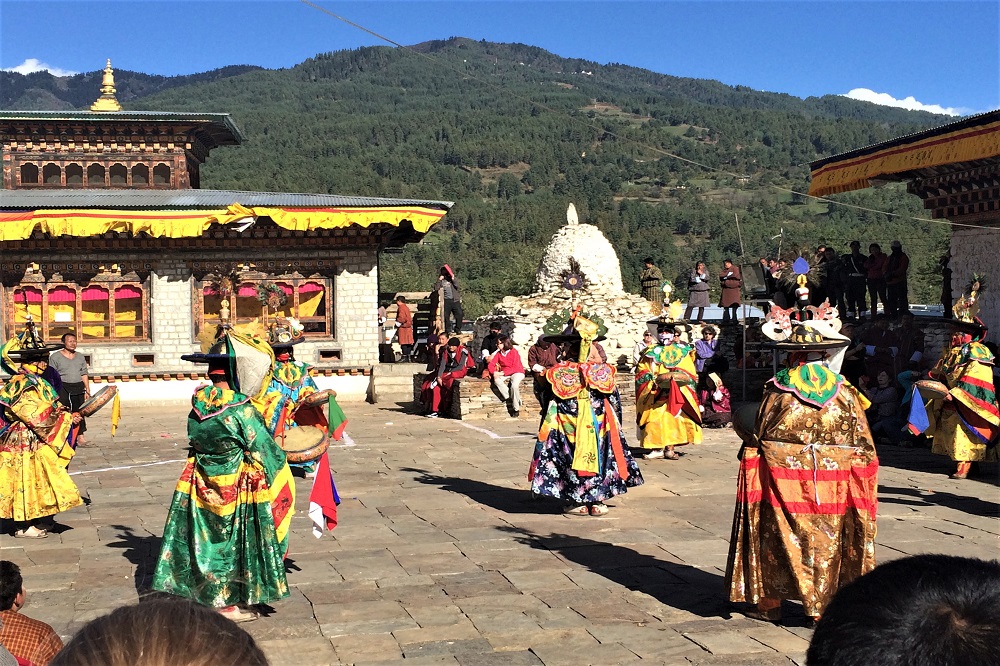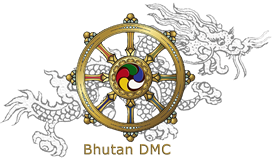Jambay Lhakhang Drup - The most distinctive festival of Bhutan where sacred dances are performed by a troupe of naked men and ‘fire dance’ to bless infertile women

The ancient Jambay Lhakhang (temple) is located in Bumthang (also known as Jakar) in the central part of Bhutan. It is one of the oldest temples in the Kingdom, founded by Songtsen Gampo, a Tibetan King in the 7th century AD. The King was destined to build 108 temples known as Thadrul – Yangdhul (temple on and across the border) in a day to subdue a demoness residing in Himalayas, in order to smoothly introduce Buddhism in the country. King Songtsen Gampo built a series of 108 temples throughout the Himalayas, in a single day, each one helping to pin down the demoness. Four were built to pin down her shoulder and hips, four more on elbow and knees and four to hold down her hand and feet. According to legends, the Jambay Lhakhang was built to pin down the left knee of the demoness and with this and other temples demoness was pinned to earth forever, allowing King Songtsen Gampo to introduce Buddhism in Tibet. Of the 108 temples supposedly built to defeat the demoness only a handful remain, and this include Jambay Lhakhang, one of the oldest and most sacred shrines in Bhutan (The second one is Kyichu Lhakhang in Paro that was built on same day).
Legends say that Guru Rinpoche visited the site several times and deemed it exceptionally sacred. Chakhar Gyab, the King of Iron Castle of Bumthang renovated the temple in 8th century AD. The first King of Bhutan, Gongsar Ugyen Wangchuck constructed the Dus Kyi Khorlo (Kala Chakra Weel of Time) inside the temple to commemorate his victory over his rivals Phuntsho Dorji of Punakha and Alu Dorji of Thimphu, after the battle of Changlimethang in 1885. Later, Ashi Wangmo, the younger sister of second King of Bhutan, built the Chorten Lhakhang. The main relics include the future Buddha, Jowo Jampa (Maitreya) from whose name the present name of temple is derived.
The annual Jambay Lhakhang festival is hosted here to commemorate the building of temple and to honour Guru Rinpoche (Guru Padmasambhava), an 8th century Buddhist master who consecrated the Jambay Lhakhang temple. The sacred festival features different dances but two are considered more important. The first one is Mewang or ‘Fire Dance’ which is held in the evening to bless infertile women in the hope that they may later bear children. The second one is the Tercham, or ‘Naked Dance’, during which sixteen naked men dance around the temple. Its link dates back to 8th century, when a band of devil was causing a havoc in the area. To distract the devils, the local men performed a naked dance, their unclothed antics leaving the devils spellbound and rendering them harmless.
HOTELS IN THIMPHU
HOTELS IN PUNAKHA & WANGDUE
HOTELS IN GANGTEY
HOTELS IN TRONGSA
HOTELS IN BUMTHANG
HOTELS IN MONGAR
HOTELS IN TRASHIGANG
HOTELS IN SAMDRUP JONGKHAR
HOTELS IN PHUENTSHOLING
HOTELS IN HAA
HOTELS IN GELEPHU
HOTELS IN ZHEMGANG
RESTAURANTS IN PARO
RESTAURANTS IN THIMPHU
RESTAURANTS IN PUNAKHA
TOUR ITINERARIES
TREKKING ITINERARIES
SPECIAL INTERESTS TOURS
UNIQUE FESTIVALS & FAIRS
BLOG


